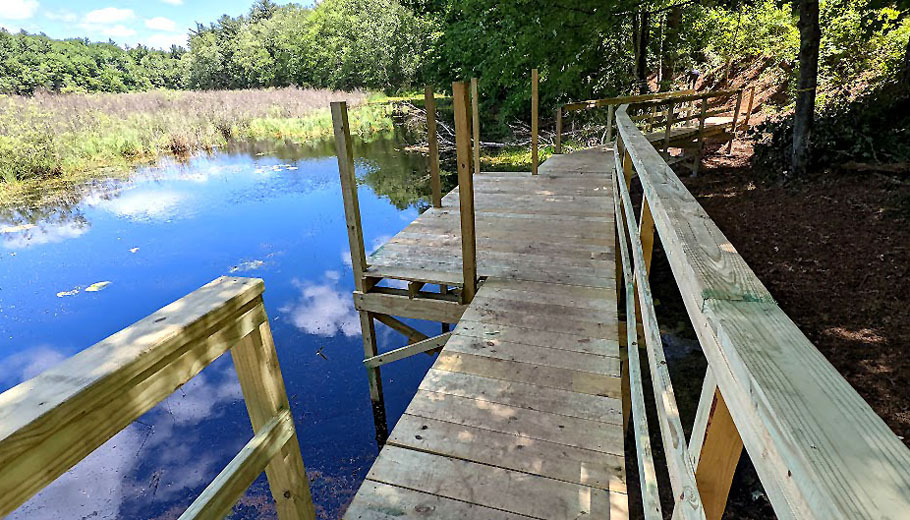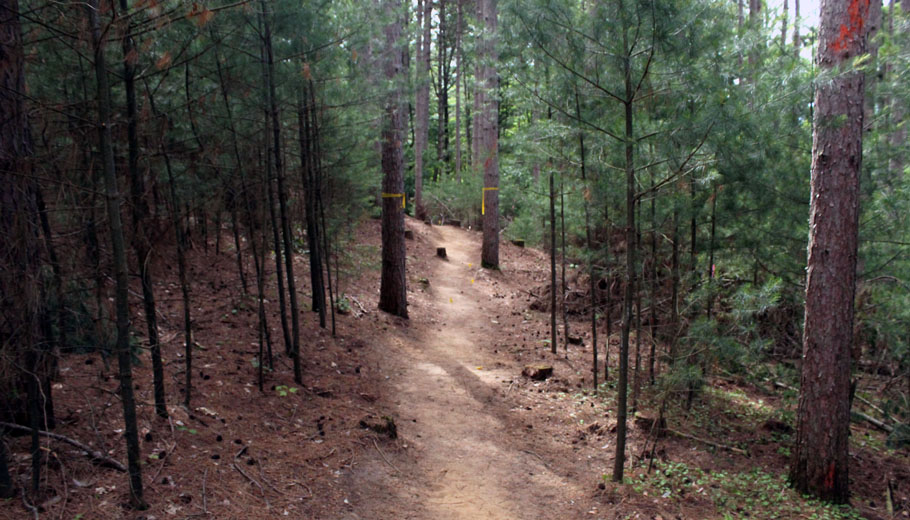
Skiers, hikers won’t have to share trail
By Greg Seubert
A shared trail system between hikers and cross-country skiers kept a stretch of the Ice Age National Scenic Trail in Waupaca County off limits to hikers in the winter.
That won’t be the case after a new stretch of trail on Iola Winter Sports Club property is completed.
More than 100 volunteers showed up June 22-26 to help build the 1 1/2-mile long trail and reopen a nearby stretch of trail in Portage County.
The IWSC project has been in the works for years, according to Debbie Krogwold, a longtime member of the Portage/Waupaca County chapter of the Ice Age Trail Alliance.
“During the winter, it is closed to hiking because of the ski trails,” she said. “Now, we’re getting the trail off of the ski trails. It’ll be year-round access and it’s a beautiful layout. We’re really excited to get this done.”
Meanwhile, the newly named New Hope segment in Portage County is now open after a three-year closure due mainly to high water.
Patrick Gleissner is the Alliance’s trail operations coordinator. His job includes coordinating volunteers for trail-building events and providing support to local chapters.
“We’ve had trail at the Iola Winter Sports Club for 15, 20 years,” he said. “We’ve always overlaid on the existing ski trails. These are groomed trails in the winter and it’s not nice to walk on the groomed trails. With the expansion of the club, we’ve been able to renegotiate an easement and we’re building a protected hiking-only Ice Age Trail path so that we eliminate the shared-use trails. That way, all the different use groups can be independent and not butt heads.”
“Getting off of the ski trails is going to be great,” Krogwold said. “We can actually get into the woods more and be on a trail instead of a wide path. It’s a totally new trail and a totally new experience. During the summer, the ski trails are very wide, grassy areas. Now, it’s going to be going through the woods.”
The trail project is one of the Alliance’s Mobile Skills Crew projects around the state this year.
“We’ll have anywhere from five to seven of these a year, depending on the workload and what opportunities we have,” Gleissner said. “We’ll also have 20 or 30 chapter-led projects for doing smaller trail repairs.”
Projects often take years to develop from conception to completion, according to Gleissner.
“When we get a project where we’re going to be putting new trail in the ground, we work with our local chapters and property manager to do some rough ideas of where the trail should go,” he said. “Alliance staff will then go out for a year or so on multiple visits and we’ll figure out where the trail should be. That kind of sets our scope of work on how large the project should be.
Volunteers
“At that point, it’s making sure we have all of our materials and things and we put out a call to volunteers,” he said. “They sign up and it’s a matter of making sure we have a base camp for them. We provide them with food, bring all of our tools up here in our trailers and put it together from there.”
Tom Amundson and his wife, Jean, of Lindenhurst, Illinois, stopped at the IWSC chalet June 24 to find out more about the project. They own property along the trail near County Trunk T.
“I got a letter from the Ice Age Trail Alliance saying they were going to be working on our property this week,” Amundson said. “We thought we’d come up, meet the people and see what they’re doing. The house where my dad grew up is a half-mile from here and the property that the Ice Age Trail runs through is where my mother grew up. It was my mom’s property until she passed away and now it’s our property. We just came to see what they’re doing.”
Amundson recalled visiting the property several times as a child years before the Alliance developed the Ice Age Trail system.
“I’ve come here since I was a little kid and spent summers with my grandfather,” he said. “Going back and fishing on Budsberg Lake with my grandpa, that was the big thing.”

Trail features
The 1,000-mile-long Ice Age Trail – entirely in Wisconsin – highlights geological features that glaciers left more than 12,000 years ago and is one of only 11 national scenic trails.
Those features include hills, kettle lakes and large boulders also called erratics.
Locally, the Ice Age Trail crosses back and forth between Waupaca and Portage counties and the Alliance’s Portage/Waupaca chapter maintains more than 23 miles of trail over five segments: Waupaca River (4.9 miles); Hartman Creek (5.6 miles); Emmons Creek (2.6 miles); Skunk and Foster Lakes (4.4 miles); and New Hope-Iola Ski Hill (5.6 miles).
“The genesis of the trail was to highlight the glaciation that came through Wisconsin,” Gleissner said. “A lot of other trails will have a reason behind them, but this interprets a unique and important era in geological history. Wisconsin is kind of a jewel for that because we have so many geological features that are available to us. We sometimes take the trail to a more difficult location to highlight those features.”
Getting materials back in the woods to build trail sections can sometimes be very difficult, Gleissner said.
“Here, we’re very lucky because we have a network of trails we can drive on,” he said. “Sometimes, we have to put a boardwalk back in the woods and it’s people literally hauling wood.”
Gleissner called the Ice Age Trail one of Wisconsin’s hidden gems.
“It’s in a lot of peoples’ backyards, but it also provides a reason for people to explore different parts of the state,” he said. “A lot of people attempt to hike the entire trail, we call them thousand milers. Once people hit the section of trail by their backyard, they get hooked and say, ‘I want to see more of this trail.’
“Maybe it’ll take them up to Rusk County, down to Janesville or different places they haven’t been before,” he said. “We have trail communities, areas that have partnered with us to build tourism or awareness of the trail. If people are traveling across the state to hike the trail, it gives them a town to explore.”
